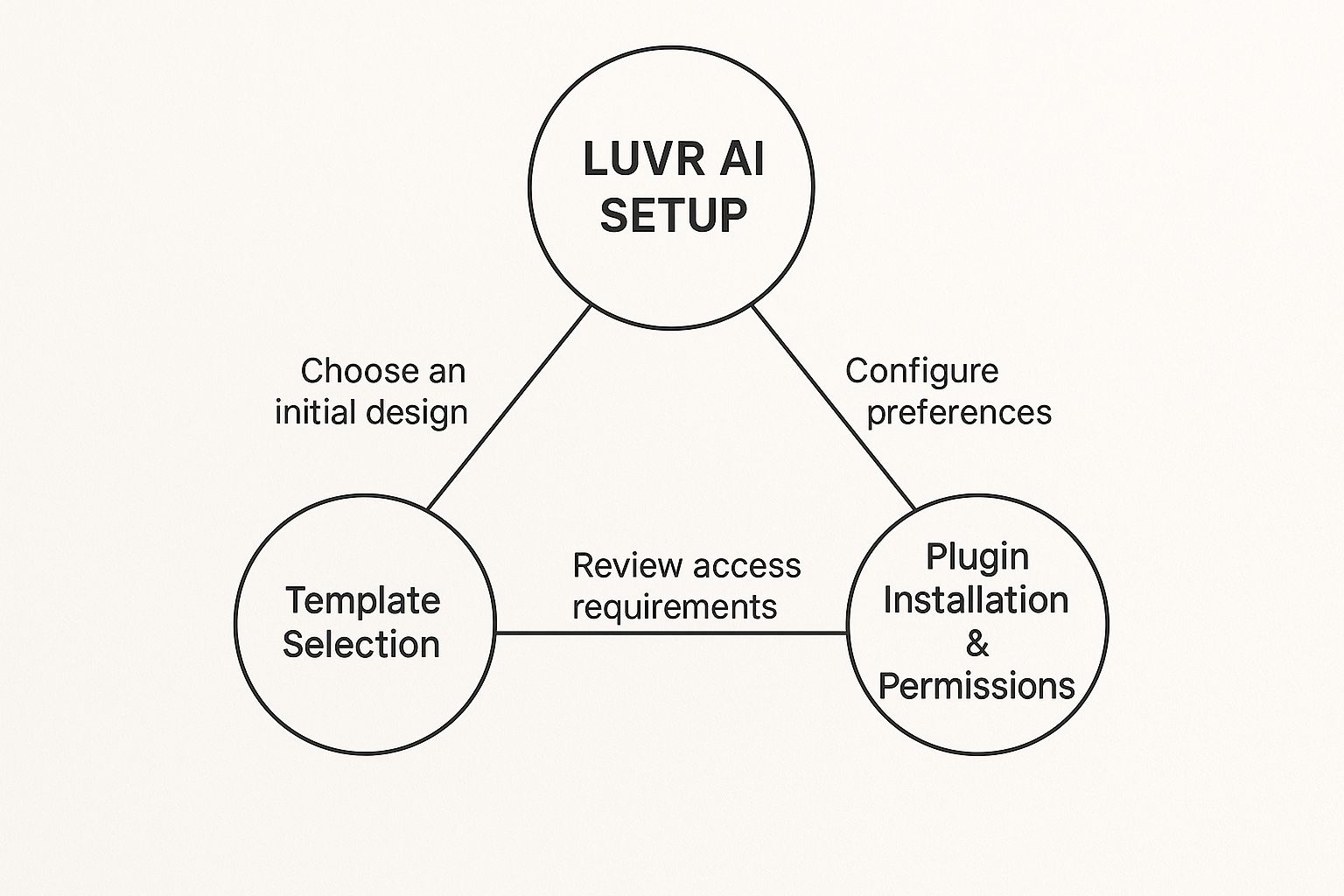Create Your Own AI Girlfriend 😈
Chat with AI Luvr's today or make your own! Receive images, audio messages, and much more! 🔥
4.5 stars

Jail role play is all about diving headfirst into a rich, narrative-driven story set inside a prison. It’s a chance to explore some pretty heavy themes—power, confinement, justice—all from the safety of your screen. When you're using a platform like Luvr AI, this means you get to use incredibly detailed prompts and character backstories to build a story that feels real and pulls you in.
What Makes Jail Role Play So Compelling

There's something uniquely gripping about stepping into a virtual cell block. It’s more than just a new backdrop; it's a deep dive into complex psychological territory. You’ve got this built-in tension between the guards and the inmates, between freedom and being locked up, and that conflict is a powerful engine for storytelling. We’re not just playing a part here; we're trying to get inside the heads of people and understand what drives them in extreme situations.
This is where a tool like Luvr AI really shines. It lets you get granular with every single detail, building a world where the AI responds intelligently to your every move. No two sessions are ever the same. The real magic happens when you mix those authentic environmental details with the high emotional stakes of the story, creating something that feels both intense and completely safe.
Key Elements of Immersive Scenarios
If you want your jail role play to feel truly authentic, you've got to build the world from the ground up. It’s not enough to just say, "we're in a prison." You need to layer in the kind of details that hit you on a gut level.
Think about weaving in elements like these:
- Atmospheric Details: Talk about the sharp, sterile smell of disinfectant hanging in the air. Mention the distant, echoing clang of a steel door slamming shut, or the constant, low hum from the fluorescent lights overhead. These sensory details make the world feel solid.
- Structured Routines: Life inside is run by the clock. Bring that into your story with mandatory headcounts, scheduled meals in a loud mess hall, or specific times for yard access. When you establish a routine, any disruption feels ten times more dramatic.
- Power Dynamics: Every prison has a pecking order. Figure out who runs the show among the inmates. Which guards are hard-asses, and which ones are more lenient? These relationships are what will truly drive your narrative forward.
A truly compelling role play isn't defined by the setting alone, but by the believable struggles and choices of the characters within it. The most memorable scenarios emerge when participants feel the weight of their decisions.
By focusing on these components, you're not just setting a scene; you're creating a living, breathing world where every choice matters and the story can go in some truly unexpected directions.
Setting Up Luvr AI For Jail Role Play
Turning Luvr AI into a believable stage for your jail role-play is easier than you might think. Getting the initial setup right is key—it saves you from wrestling with technical stuff later, so you can jump right into creating a story that pulls you in.
Your first decision is the foundation: the template. Luvr AI has a few ready-to-go scenarios, but the real magic happens when you make it your own. You could start with something basic like an "interrogation room" and add your own flavor, or you can build your world from the ground up. For total control, head over to the Luvr AI creation builder and start crafting.
Fine-Tuning Your Environment
Once you've got the basic structure, it's time to sweat the small stuff. This isn't just about writing descriptive text; it’s about dialing in the AI’s behavior and making sure your session is secure. Authenticity comes from the details.
- Lock Down Privacy: First things first, set your sessions to private. This is non-negotiable. It keeps your story contained and prevents any accidental leaks.
- Assign Permissions Carefully: If you're bringing others into the scenario, be smart about permissions. Decide who can edit character backstories and who can only interact in the chat.
- Back-Up Your Logs: Make a habit of exporting your conversation logs. It’s a simple step that protects your story from being lost and gives you a way to revisit key moments.
This concept map breaks down the core pieces of your Luvr AI setup.

As you can see, your choice of template, your security settings, and how you manage any add-ons all work together. Get one part wrong, and the whole thing feels off.
Remember, a secure and well-defined environment is the foundation of creative freedom. When you're not worried about technical settings, you can fully immerse yourself in the story.
The goal is to create a seamless experience where you can manage everything without breaking character.
Designing Realistic Jail Scenarios

To craft a jail role-play that really pulls you in, you need to go beyond just four walls and a metal door. The secret to a truly immersive experience lies in a blend of predictable routine and sudden chaos. I always start by outlining the daily rhythm of the facility—this creates a believable foundation, making any disruption feel genuinely jarring and significant.
Think about the world beyond the cell. Who else is there? Flesh out the key non-player characters (NPCs). Are the night-shift guards lazy or hyper-vigilant? Is the warden a by-the-book hardliner or is the deputy running a side hustle? Establishing an inmate pecking order with rival groups and a clear leader instantly introduces tension and opens up countless story possibilities.
Building Tension and Immersion
The key to keeping a player hooked is mastering the narrative's ebb and flow. Don't hit them with a full-blown riot on day one. Instead, let the pressure build slowly. A surprise shakedown of the cells, an unexpected lockdown, or the arrival of a new inmate who doesn’t respect the established order—these are perfect ways to stir the pot.
These kinds of dynamic events are what make a story breathe. They push characters to make tough choices, revealing who they really are and driving the plot forward naturally. You can also weave in small sensory details to crank up the atmosphere. Describe the distant, echoing clang of a steel door, the sharp smell of antiseptic, or the unnerving buzz of a flickering fluorescent light.
The most powerful scenarios often borrow from reality. Drawing on real-world issues like overcrowding or subpar medical care, as detailed in reports like the Global Prison Trends 2025, can add a gritty layer of authenticity. Understanding the real pressures of incarceration gives your story a weight and depth that's hard to fake.
The most immersive scenarios feel alive because they operate on a schedule. When you define the routines—like meal times and yard access—any deviation immediately creates a sense of urgency and danger.
To help you organize these moving parts, I've put together a quick breakdown of the core elements and why they matter.
Scenario Elements Breakdown
| Element | Purpose | Example |
|---|---|---|
| Daily Routine | Creates a baseline of normalcy, making disruptions feel more impactful. | "The 6 AM wake-up call is followed by a silent breakfast in the mess hall." |
| Key NPCs | Populates the world with distinct personalities who can act as allies or antagonists. | "Officer Miller, a grizzled veteran who sees everything but says nothing." |
| Inmate Hierarchy | Establishes social dynamics, creating natural sources of conflict and alliances. | "The 'Old Heads' run the west block, while a new, younger crew controls the yard." |
| Dynamic Events | Introduces unpredictability and forces characters to react, driving the story. | "A sudden lockdown is called. A rumor of a snitch spreads like wildfire." |
| Sensory Details | Enhances immersion by appealing to the senses and creating a tangible atmosphere. | "The air is thick with the smell of stale sweat and industrial cleaner." |
Thinking through each of these components will give your world the texture it needs to feel real.
If you want a more guided approach to get started, you can create a new scenario in Luvr AI and use its tools to map out your plot points and characters. It’s a great way to streamline the setup process.
Crafting Convincing Character Backstories

Let's be honest, a good jail role play lives and dies by its characters. You can build the most detailed, gritty prison setting, but if the people inside are flat, the whole thing falls apart. The most unforgettable characters, whether they're inmates or guards, aren't one-dimensional caricatures. They're messy, flawed people with secrets to keep.
The trick is to give your character a powerful hook—a secret or a burning motivation that drives them. This one element is the engine for your story. Maybe a guard has a crippling gambling debt, making them an easy target for a bribe. An inmate framed for a crime they didn't commit will have a completely different outlook than a career criminal who knows the system inside and out.
It's these little personal details that ignite the most interesting conflicts and create unexpected allies. That’s where the real drama is.
Giving Your Characters Depth
To really make your characters breathe, you have to look past the uniform or the prison jumpsuit. What’s their history? What are their quirks? Who are they connected to, both inside the prison and on the outside? Every action they take should be colored by their past.
Stuck for ideas? Try asking yourself a few questions:
- For an Inmate: What was their life like before all this? Who’s waiting for them on the outside? Do they have a unique talent—maybe they're a master negotiator or know how to get things—that makes them valuable?
- For a Guard: What led them to this job? Are they burned out and cynical, or a true believer in the system? How does their home life spill over into their work?
True character depth isn't about writing a long biography. It’s about choosing one or two core motivations that influence every decision your character makes. Redemption, survival, or revenge can drive powerful stories.
Digging into these questions helps you weave a rich tapestry of relationships that will inevitably lead to high-stakes moments. If you need a little inspiration, a great starting point is to explore Luvr AI characters and see the kind of detailed personas already out there.
Bring Your World to Life with Real Prison Data
If you want to create a truly immersive jail role play, nothing grounds the experience like using real-world data. It's the secret ingredient that takes your scenario from a generic story to a powerful reflection of genuine systemic issues, which in turn sparks much deeper, more meaningful interactions. Instead of just making up numbers, you can anchor your narrative in facts.
Think about it. You could set your story in a facility struggling with severe overcrowding. To make that feel real, you can mention that as of early 2025, the U.S. had over 1.8 million incarcerated individuals—the largest prison population on the planet. Just that one statistic instantly creates high stakes and a sense of resource scarcity. If you want to dig deeper, you can explore global incarceration trends for even more context.
Weaving Data into Your Story
So, where do you find this information? It's easier than you think. Official sources like government justice department websites or nonprofit research groups are treasure troves of statistics. The real art is in how you introduce it.
- Warden's Briefing: Draft a "warden's weekly report" that includes actual demographic breakdowns.
- Guard's Memo: Give a guard character a memo detailing inmate population shifts based on real regional data.
- Character Dialogue: Let your characters talk about recent news reports on incarceration rates, connecting their personal struggles to the bigger picture.
Anchoring your narrative in real data does more than just boost immersion. It encourages everyone involved to think critically about the complex, often hidden realities of the justice system. That’s how you create a truly thoughtful and impactful experience.
Using real numbers respectfully transforms your role play into a powerful storytelling tool. It’s a small touch that makes a world of difference.
Reflecting the Squeeze of the Justice System
The real tension in any good jail story isn't just about what happens inside the cell block. It’s about the crushing weight of the system pressing in from the outside. If you want to create a truly immersive experience, you need to simulate the slow, grinding gears of the justice system itself. That's where the most powerful drama lives.
Think about it. Being locked up is one thing. But feeling the overwhelming pressure of a legal battle you have absolutely no control over? That's a whole other level of intensity. It forces your character to make impossible choices.
For example, what happens when a prosecutor offers a plea deal? It’s a classic dilemma for a reason. Does your character take the deal, maybe even admitting to something they didn't do, just to get a shorter, guaranteed sentence? Or do they roll the dice and risk a much longer prison term by going to trial? That kind of high-stakes conflict is gold for role-playing.
Weaving in Procedural Roadblocks
To bring these real-world pressures to life, you can throw in events that mirror the maddening pace and complexity of the legal process. These external forces make the jail feel less like a stage and more like a direct consequence of a massive, impersonal machine.
Here are a few ideas I've seen work incredibly well:
- The Bail Hearing That Never Comes: Suddenly, there's a "backlog" at the courthouse. Your character's bail hearing, their one shot at getting out, is pushed back by weeks. Imagine the psychological toll that takes.
- The Rules Change Overnight: Maybe a new warden comes in, or a new state law gets passed. All of a sudden, visitation rules are stricter, or lockdown protocols are different. This forces your character to constantly adapt just to survive.
A huge part of this is understanding the reality of pretrial detention. A staggering 2023 analysis showed that the vast majority of people in U.S. jails haven't even been convicted of a crime. Their numbers are nearly back to pre-pandemic levels. Tapping into this reality—where someone’s freedom is on the line long before a jury ever hears their case—adds a layer of stark, uncomfortable realism to the whole scenario. For a deeper dive, the Prison Policy Initiative's report on incarceration trends is an eye-opener.
The best role-play moments I've ever experienced came from a sense of helplessness. When a character's entire fate is tangled up in paperwork, legal games, or systemic delays, their personal struggles behind bars suddenly become so much more meaningful.
Troubleshooting Your Jail Role Play
So, you've got your scenario all mapped out, but even the best-laid plans can go sideways. It happens. You might find your AI guard suddenly developing a soft spot, or the realism might start feeling a little too real. Let's tackle some of the most common hiccups you'll run into and how to smooth them out on the fly.
Keeping Your AI Character on Track
One of the most frustrating things is when an AI character gets amnesia. Your hardened, cynical inmate suddenly starts talking about their happy childhood, completely derailing the mood. It shatters the illusion.
The trick is to gently and consistently nudge the AI back into character. Don't just set the personality once and forget it. Weave reminders into your prompts. For example, you might say, "Remembering your promise to the old warden, you..." or "As a guard who's seen it all, you're unfazed by the commotion and..." These little reinforcements act as guardrails, keeping the AI's personality from drifting.
Walking the Line Between Realism and Safety
Jail scenarios can get intense, and finding that sweet spot between gritty authenticity and making sure everyone is comfortable is crucial. This isn't just about rules; it's about respect.
- Set Hard Boundaries Upfront: Before a single line of dialogue is written, use the settings in Luvr AI to define your no-go zones. Be explicit about what topics are off-limits.
- Establish a Safe Word: This is non-negotiable. Pick a simple word that has no place in the scene, something like "red light" or "pause." It’s an instant emergency brake anyone can pull if things get too overwhelming.
- Check In Afterwards: After a particularly heavy scene, step out of character for a minute. A quick "Everyone good?" can make all the difference and ensures the experience stays fun for everyone involved.
How Do I Keep a Solo Scenario Interesting?
When you're running a solo role play, you're both the star and the director. If you just sit back and wait for the AI to entertain you, the story can stall out pretty quickly. You have to be the one to stir the pot.
Don't be a passive observer in your own story. You have to be the agent of chaos. Start a rumor, hide something forbidden, or stage a fake fight. Your proactive decisions are what will force the AI to react in new and exciting ways.
When you push the narrative forward, you create a genuinely unpredictable experience that feels alive, rather than just a back-and-forth conversation.
Ready to create your own unforgettable story? Luvr AI gives you the keys to the kingdom. Dive in and start building your world today at https://www.luvr.ai.



